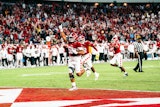 Dr. Robin L. Hughes
Dr. Robin L. HughesIt seems like at least once a week I balk at the rhetorical and so-called “politically correct — yet acidic” and “shade-like” mantra that reminds athletes that they are students first. My response is that they can and must do both and why do we constantly need to remind them that they are students first. These constant reminders imply that someone always seems to forget and throws some shade that someone’s “priorities are not quite in order.”
However, one does not have to give up one’s identity in order to accommodate the other. How folks, including athletes, negotiate different context is highly dependent upon which identity is likely used in a particular situation and sometimes both identities are at work depending on the context and the task. And, don’t all identities intersect at some point?
For example, I live in an academic space as professor, administrator, mother, and parent. I operate and negotiate between those “performance identities” and sometimes all three are at odds [my children roll up to my office to ask for money—I am mother, not the Executive Associate Dean]. However, I am still always operating in one or multiples of those performance spaces. How I respond in multiple positions has something to do with my racial identity, gender, sexuality, and quite frankly who I am at home, etc. Young folks, like an intercollegiate athlete, operate in multiple spaces, too.
Interestingly, athletes are always asked to pay attention to one identity as opposed to another. Yet other students who are gifted in multiple domains are not questioned. For example, think about other gifted students, musical instrument players, singers, dancers, and thespians; are they routinely asked to “remember” their identity as students first? Their talents are not preceded with “student”—i.e., student ballerina, student opera singer, student musical instrument player.
Have we ever stopped to ask ourselves why there is a push to choose one identity in athletics as opposed to choosing an identity in another performance area—like, dance, music and the like? I don’t think the answer is so simple nor is it warm and fuzzy. In fact, I would suggest that we think about who is located where. Who makes it “rain” and what do the rainmakers look like? In other words, whose interests are converging?
There is an undergirding of complexities that surrounds how we construct, understand and know “athletics and an athlete” that goes unquestioned. We begin the construction of athletics early, and it is laced with how we have been socialized to think about and “know” gender, race, socioeconomic status and how we understand educability and construct “giftedness.”
This construction of athletics and athletes is tied to how we “believe that we know and understand giftedness”—and how we constrict those meanings about “certain folks” and performances. How have we constructed performance, art and culture? We seem to pay lots of attention—and restrict those who participate in revenue-generating sports. Hmmm, wonder why?
I have listed seven shade-like reasons that I hear most often:
- Work, work, work, work, work, work, work. Some argue, in a strange way, that some performance categories prepare one for work as dance, theater, and music teachers and the same folks seem to balk at the idea that sports like football and basketball serve similar purposes. My counter? Who do you think teaches athletics, manages athletics, coaches teams, and owns sports clubs, etc.? Wouldn’t it seem logical that a basketball coach or football coach more than likely has played basketball or football—in college or majored in health and kinesiology?
- The hyper-sensationalization of sporting and pay! We all assume that athletes are “making it rain” in athletic departments. Athletics is structured in such a way that many coaches, etc., rely heavily on the athletic performance of 17- to 22-year-olds who play basketball and football. Other performance categories, like dance and music, tend not to generate significant revenue dollars, and, when they do, I am not sure that anyone gives a hoot. However, other folks are also getting paid in those “academic” spaces. They just have the luxury of the first name Dr. and not coach. And those rainmakers are subsidized through full tuition dollars. Think of it like this: other “coaches,” those with Dr. in front of their names, well, are tenured. So they get paid no matter what. They make it rain even when the sun is shining.
- Talk to the hand. Coaches, professors and administrators in higher education and folks who exist outside athletics need to remind themselves that students have multiple identities—don’t just remind the athletes. I can speak for myself as professor. Quite frankly, none of us professors draws a crowd to watch us perform in a stadium or classroom filled with tens of thousands. No one serves popcorn, hot dogs and drinks while any of us lectures and none of the bookstores sell jerseys with our numbers or our names across the back. I have yet to have folks cheer when I enter a room (somehow I could be OK with that). So, how does one easily remind themselves that one’s identity is more important than another and why should they have to? Seems logical that we would support students who are athletes to maintain multiple healthy identities.
- It’s simply self-loathing, revenge of the nerds, pathology (see hateration). Ostracizing and scrutinizing athletes is plain and simple—pathological. One of my co-authors describes it as self-hate harbored from being chosen last on the playground (James Satterfield). Some folks would like to believe that individuals who excel in sports do not necessarily excel in the classroom. So the last on the playground, wanna-be nerds, can pretend that athletes are brawn only—no brains. Reminding athletes that they are students first reeks of an historical artifact—that hard working class folks participated in sports and children of the upper classes participated in music and dance—and classy sports like tennis and golf. It is also interesting that statistics of revenue-generating sports are always referenced and reminded. That would be basketball and football. Hmmm.
- Exhaustion from amateur status. Much of the mantra of student first provides lip service but let’s remember the little fact that these students’ performances might generate mega-revenue to institutions, but please be reminded also that those athletic performances are to be also considered “amateur.” In other words, if we keep telling “ourselves” students first, we might actually believe that WE are putting mega bucks generating students first, and then we don’t feel so guilty about getting paid from those amateurs.
- Concern about welfare of athletes, interest converge. It’s always nice to know that so many people are concerned about how athletes fare after college, especially those who participate in revenue-generating basketball and football. This assertion is interesting given that those two sports are disproportionately comprised of African-American males. Even more interesting, all that concern about athletes, yet no one seems to be too concerned about the same population of students when they are not participating in revenue-generating sports. Oh, and by the way, black males are less likely to be hired with a college degree than whites with a high school education. Are we concerned about racism that exists in employment?
- Dream killers. We can rattle off stats of the probability of becoming professional athletes. That someone would dare consider working so hard at their sport in which they are gifted is equated with some fate worth than death [typically just basketball and football, tho….wonder why?]. Yet we don’t afford similar stats to parents of “sticker on the back of the car geniuses.” How many parents believe their little “honor students” at fill in the blank school are going to become the next president of the United States, brain surgeon, Supreme Court justice, or just rocket scientist?
I have those numbers just in case we all want to become dream killers. The odds of becoming president are about 1 in 10,000,000. Of becoming an astronaut, to which there are various routes, is about 1 in 600 for a rocket scientist. An astronaut who flies to the moon, Mars or some other star, the odds decrease to about 1 in 42,000,000. Oh yeah, the odds of becoming a saint, many folks are parents to angelic like creatures, too. That figure is about 1 in 20,000,000.
So if one is thinking about presidency, or an astronaut, might as well think about putting in an application for sainthood. You are just as likely—or more than likely to become a saint than an astronaut. Perhaps we should consider a new bumper sticker. I will let the reader decide what it should say.
Dr. Robin L. Hughes is interim executive associate dean in the School of Education at Indiana University.
















